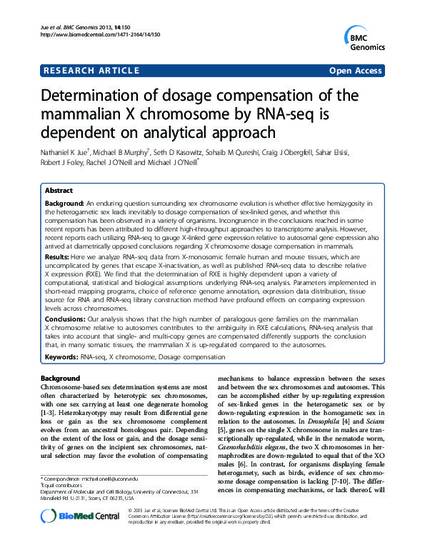
Article
Determination of dosage compensation of the mammalian X chromosome by RNA-seq is dependent on analytical approach
BMC Genomics
(2013)
Abstract
Background: An enduring question surrounding sex chromosome evolution is whether effective hemizygosity in
the heterogametic sex leads inevitably to dosage compensation of sex-linked genes, and whether this compensation has been observed in a variety of organisms. Incongruence in the conclusions reached in some recent reports has been attributed to different high-throughput approaches to transcriptome analysis. However, recent reports each utilizing RNA-seq to gauge X-linked gene expression relative to autosomal gene expression also arrived at diametrically opposed conclusions regarding X chromosome dosage compensation in mammals.
Results: Here we analyze RNA-seq data from X-monosomic female human and mouse tissues, which are
uncomplicated by genes that escape X-inactivation, as well as published RNA-seq data to describe relative
X expression (RXE). We find that the determination of RXE is highly dependent upon a variety of
computational, statistical and biological assumptions underlying RNA-seq analysis. Parameters implemented in
short-read mapping programs, choice of reference genome annotation, expression data distribution, tissue
source for RNA and RNA-seq library construction method have profound effects on comparing expression
levels across chromosomes.
Conclusions: Our analysis shows that the high number of paralogous gene families on the mammalian
X chromosome relative to autosomes contributes to the ambiguity in RXE calculations, RNA-seq analysis that
takes into account that single- and multi-copy genes are compensated differently supports the conclusion
that, in many somatic tissues, the mammalian X is up-regulated compared to the autosomes.
Keywords
- RNA-seq,
- X chromosome,
- Dosage compensation
Disciplines
Publication Date
2013
DOI
10.1186/1471-2164-14-150
Citation Information
Nathaniel K. Jue, Michael B. Murphy, Seth D. Kasowitz, Sohaib M. Qureshi, et al.. "Determination of dosage compensation of the mammalian X chromosome by RNA-seq is dependent on analytical approach" BMC Genomics Vol. 14 Iss. 1 (2013) Available at: http://works.bepress.com/jue-nathaniel/4/
Creative Commons license

This work is licensed under a Creative Commons CC_BY International License.
